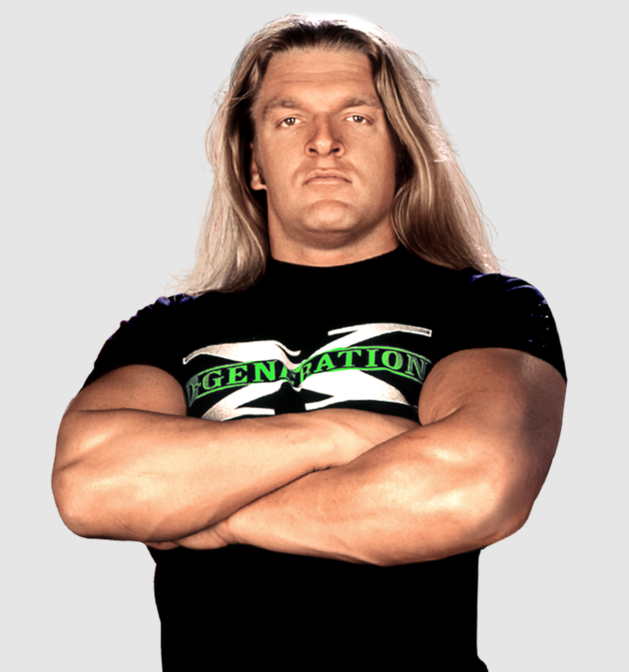WWE: The New Era of Wrestling
Maria Morales
It's cool to love professional wrestling again! Those are seven words that I did not believe I'd say in my adult life. After all, I've watched wrestling my entire life, but I left the fandom back in 2014 because it was just so damn stale. With the same old gimmicks, Vince McMahon interfering in what felt like every storyline, and talent that just wasn't entertaining in the ring, the WWE felt lame. Really lame. Yet, after witnessing the marvelous spectacle that was Wrestlemania 40 earlier in April, there's no question that professional wrestling, specifically the WWE, is more popular than ever. And it's due primarily to one person, Paul Levesque.
DX Leader - Triple H
Most people know Levesque by his ring persona, Triple H. He was a founding member of the wildly popular Degeneration X factor during the promotion's Attitude Era in the late 1990s and early 2000s. And while his hall-of-fame career in the ring goes without question, what he has done since his retirement has changed the trajectory of the WWE. After various leadership stints within his storyline, Levesque's role in the promotion was solidified when he became an Executive Senior Advisor with an office at the company's headquarters in Stamford, Connecticut, in 2010. By 2011, he was appointed Executive Vice-President of Talent and Live Events, a title that expanded to Executive Vice-President of Talent, Live Events, and Creative in 2013. This advancement allowed him to select new talent and collaborate with WWE's creative team on storylines, testing different angles, creating a more global locker room, and bringing professional wrestling to a new, more diverse audience. Levesque was integral to the development and executive production of WWE's NXT brand, the company's developmental show, since 2014. And while Triple H's rise wasn't without controversy (there were accusations from the locker room that he was using his newfound authority to book premium matches for himself), the transition was generally well-received. In 2020, Levesque became Executive Vice-President of Global Talent Strategy and Development, overseeing talent development and advising the CEO on talent strategy after his forced retirement from the ring due to a heart condition.
Vince McMahon
On July 22nd, 2022, WWE further promoted Levesque to Executive Vice President of Talent Relations. Three days later, he assumed the role of Head of WWE Creative after his father-in-law and WWE CEO Vince McMahon's initial retirement amid misconduct allegations. Later, on September 2nd, he was appointed Chief Content Officer, overseeing various departments, including creative writing, talent relations, live events, talent development, and innovative services. However, many fans believed that his authority over the creative aspect of the company was cosmetic, as McMahon's retirement was short-lived. McMahon returned to the company a few months later and promptly began altering the storylines Levesque had been developing. McMahon was notorious for his bias toward a specific type of talent, such as Brock Lesnar, and for creating personas that were offensive at best and outright racist at worst.
On October 15th, 2023, Endeavor CEO Ari Emanuel transferred creative control from McMahon to Levesque, tasking him with leading the creative direction of WWE moving forward. The move was celebrated by fans tired of McMahon's outdated stories, not to mention the general ick he gave off. Levesque's creative control was finally solidified earlier this year when McMahon was permanently removed from the company amid a new lawsuit with even more heinous allegations of sexual misconduct and employee abuse.
McMahon was known for his tyrannical approach to running the company, not allowing the talent to have much say in how they were portrayed on screen. Triple H has been applauded for being the exact opposite. He has allowed the talent to be who they are and to bring out the best in the characters and storylines they create together. But that wasn't the only reason he felt like a breath of fresh air. He has expanded the promotions creative team to develop storylines that could be enjoyed universally and didn't rely on stereotypes and antiquated tropes (sorry, Cryme Tyme)
Levesque has also concentrated a ton of effort and resources on the company's charitable arm, with talent engaging in multiple philanthropic events in every city the promotion attends weekly. This brilliant move has put the talent (and company) in front of countless new eyes as local media universally covers these appearances, typically held in conjunction with organizations serving the youth and introducing the WWE to younger audiences that may not already watch their programming.
Charitable work, however, isn't enough to make the WWE cool. The product on screen has to be entertaining. And this is where the "new era" really shows. Levesque changed how new talent was recruited through their NXT brand, turning his sights to the NCAA and professional Mixed Martial Arts to find fresh talent. The women's division has likely benefited the most from this, as many of the roster's current top performers come from gymnastics and track backgrounds (sports known for their grueling training regimens). He has also continued to recruit former NCAA male athletes and professional football players. These recruiting changes have meant that the days of hefty wrestlers performing in slow-paced matches are long gone. The matches are exciting, with plenty of momentum changes and fast-paced action, which is now the norm.
(L to R) Naomi, Jade Cargill, Bianca Belair
In my opinion, Levesque's most crucial contribution is significantly updating the roster's composition. There have been decades in the WWE's past when there wasn't a single woman of color on the roster. Today, we have Bianca Belair, one of the longest-running women's champions, and many other Black, Asian, and LatinX wrestlers. The same can be said for the men's side of the locker room. From the dominance of Roman Reigns and the bloodline (all Samoan wrestlers) to the rise of Trick Williams and Carmelo Hayes from NXT, the locker room is significantly browner than it has ever been.
The changes and Levesque's vision for the future of the WWE were on full display at Wrestlemania 40, which featured the most diverse card in the promotion's history. And the fans responded with love. The weekend-long event drew the highest viewership in Wrestlemania history, smashing merchandise, social media, and gate records.
So, you want to know the real reason wrestling is cool again? It's simple. Levesque and the WWE have figured out how to incorporate diversity, equity, and inclusion for a broad global audience in a way that doesn't feel "woke" or forced. In the end, there are stories, and then there are human stories. And the WWE has realized that you can tell human stories through diverse talent that resonate with everyone. And that is pretty damn cool.








